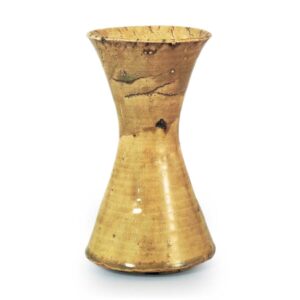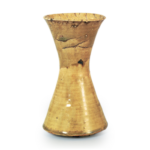
Kizeto Tachitsudo, Flower vase, Ryabimakura
Height 21.4cm, mouth diameter 10.5cm, bottom diameter 11.9cm
Important Cultural Property
Kuboso Memorial Museum of Art, Izumi City
The inscription on the side of the inner box, “Seto no sato no riuko hanayu,” is said to have been written by Sen no Rikyu, and this is a famous tool that is included in “Chuko Meimono Ki” edited by Sakamoto Shusai as a Kizeto tachitsutsumi hanayu owned by Rikyu.
The name “Ryuko” comes from its resemblance to a standing drum body, and the idea of using a standing drum body as a vessel already existed in Chinese ceramics of the Song dynasty (960-1279). It is thought that Sen no Rikyu had these vessels made as flower vases for wabi-style tea ceremonies.
The tight body and the open shape of the lower part and hem are suitable for an alcove vase. The entire surface is covered with a transparent yellow glaze, and the bottom is decorated with a low rimmed base. The yellow glaze is well melted over the entire surface, but there are fire cracks and burns around the base, and it is moist and has a deep flavor.
On the back of the lid of the inner box, Saso, the fourth generation of Urasenke, wrote “Seto Ryugo Hanabiru, Tabimakura, Rikyu’s possession, Munemuro (flower seal)”, and on the outer box, Itto, the eighth generation of Urasenke, wrote “Rikyu’s possession, Hyakkai de, Yellow Seto, Tabimakura Hanabiru, calligraphy by Soyei, outer box, Saso, with Maruita attached, calligraphy by Esen,” which is presumably the “Ryugo Hanabiru” mentioned in the morning session on 25th of January in Tensho 19 in “Rikyu hyakkaiki. It is presumed to correspond to the “Ryugo Hanayaki” described in the “Rikyu Hyakkai Ki” on the morning session of 25th of January, Tensho 19. Furthermore, according to Sakamoto Shusai’s boxed description, it is suggested that it came into Shusai’s possession after passing through Takeda Michiyasu.








